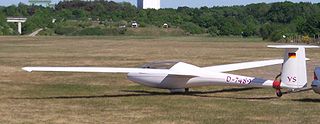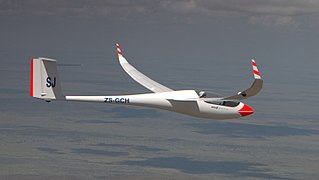
The Rolladen-Schneider LS3 is a 15 metre single-seat glider produced by Rolladen-Schneider from 1976 to 1983.

The LS11 or AFK1 is a prototype Two-Seater Class sailplane currently in development at Akaflieg Köln e.V.. The LS11 first flew on 5 November 2005.

The Rolladen-Schneider LS2 is a 15-metre span single seat glider prototype with trailing-edge flaps, designed and built by Rolladen-Schneider Flugzeugbau GmbH c. 1973.

The ASW 20 is an FAI 15 metre Class glider designed by Gerhard Waibel and built by Alexander Schleicher GmbH & Co. Its fuselage is nearly identical to that of the ASW 19, mated to newly designed flapped wings for the 15 metre Class. The prototype first flew in 1977. It proved to be a highly successful glider, winning several World Championships, and was still being flown at this level up to 1995. Developments along its production life included winglets, pneumatic turbulators, and wingtip extensions. It remained in production until 1990, when it was superseded by the ASW 27. 765 were built by Schleicher and a further 140 were made under license by Centrair in France.

The Rolladen-Schneider LS8 is a Standard and 18 metre class single-seat glider developed by Rolladen-Schneider and in series production since 1995. Currently it is manufactured by DG Flugzeugbau.
Competition classes in gliding, as in other sports, mainly exist to ensure fairness in competition. However the classes have not been targeted at fostering technological development as in other sports. Instead classes have arisen because of:

The Glasflügel 303 Mosquito is a composite 15 metre Class single-seat sailplane manufactured by Glasflügel between 1976 and 1980.

The ASW 22 is an Open Class glider built by Alexander Schleicher GmbH & Co which first flew in 1981. The 'W' in the designation indicates that this is a product of the German designer Gerhard Waibel. An ASW 22 broke the world 750 km triangle speed record in 1985 and ASW 22s have won first place in six World Gliding Championships.

|} The Jonker JS-1 Revelation is a glider built of glass-fibre, carbon fibre and Kevlar. It is available with an 18-metre span for the 18 metre class or a 21-metre span for the Open class. The manufacturer is Jonker Sailplanes of PotchefstroomSouth Africa, founded in 2004 by two brothers, Attie and Uys Jonker. The structural and chief designer is Attie Jonker, while the airfoil and main aerodynamic features were developed by Johan Bosman in co-operation with the Delft University of Technology.

The Silent 2 Targa is a single seater sailplane of Italian manufacture. It is of the FAI DU Class glider. It is sold by Alisport ready-to-fly or kit-built as pure glider or self-launching glider. The self-launching version can be fitted with a single-blade propeller belt-driven by a two-stroke engine or with a double-blade folding propeller directly driven by an electric motor.
The PIK-3 was a sailplane produced in Finland in the 1950s and 60s. It was designed to be a cheap and easy-to-build aircraft to equip the country's gliding clubs as their standard single-seat machine. It was a conventional design for its day, with a high wing and conventional empennage. Construction was of wood throughout, skinned in plywood.
The Sigma is an experimental glider developed in Britain from 1966 by a team led by Nicholas Goodhart. After disappointing performance during flight testing the Sigma was passed on to a Canadian group which carried out modifications, making the Sigma more competitive.

A glider or sailplane is a type of glider aircraft used in the leisure activity and sport of gliding. This unpowered aircraft can use naturally occurring currents of rising air in the atmosphere to gain altitude. Sailplanes are aerodynamically streamlined and so can fly a significant distance forward for a small decrease in altitude.

The EoN 460 series are wooden single-seat standard class sailplanes, built in the UK in the 1960s. It did not have major competition success but some remain in use in 2021.

The FFA Diamant is a family of Swiss high-wing, T-tailed, single-seat, FAI Standard Class and FAI Open Class gliders that was designed by engineering students under supervision of Professor Rauscher at the ETH Zurich and manufactured by Flug- und Fahrzeugwerke Altenrhein AG (FFA) of Altenrhein, Switzerland.
The Akaflieg Darmstadt D-28 Windspiel was a single-seat, high-performance sailplane designed in Germany in the early 1930s. Intended to exploit a growing understanding of thermal soaring, it was small and manoeuvrable, with a 12 m span; silk-covered for lightness, it weighed less (empty) than its pilots. It held the world straight-line distance record for a time in 1934.
The Bréguet Br 900 Louisette was a short-span, single-seat competition sailplane built in France in the 1940s. It set some French gliding records but was unsuccessful at the international level. Only six production aircraft were built.
The VTC Delfin is a competition single seat Standard class glider designed and built in Yugoslavia in the 1960s. It had some success in national competitions and went into small scale production.

The Allstar SZD-54 Perkoz is a two-seater, glider for training, aerobatics, cross country flight and cloud flying from the Polish manufacturer Allstar PZL Glider. The sailplane has exchangeable wing tips for either 17.5 or 20 metres and is manufactured primarily from glass fibre reinforced plastic (GFRP). Without wing extension, it is certified for unlimited aerobatic manoeuvres. For glider training, the short wingspan is supplemented with winglets. As a cross-country glider with a 20 metres wing and winglets, the Perkoz has a glider index of 102. The SZD-54-2 Perkoz is the successor of the widely used SZD-50-3 Puchacz trainer, which is part of the SZD family of aircraft.

The Akaflieg Stuttgart fs33 Gavilán is a high-performance two-seater class sailplane designed and built by Akaflieg Stuttgart.















